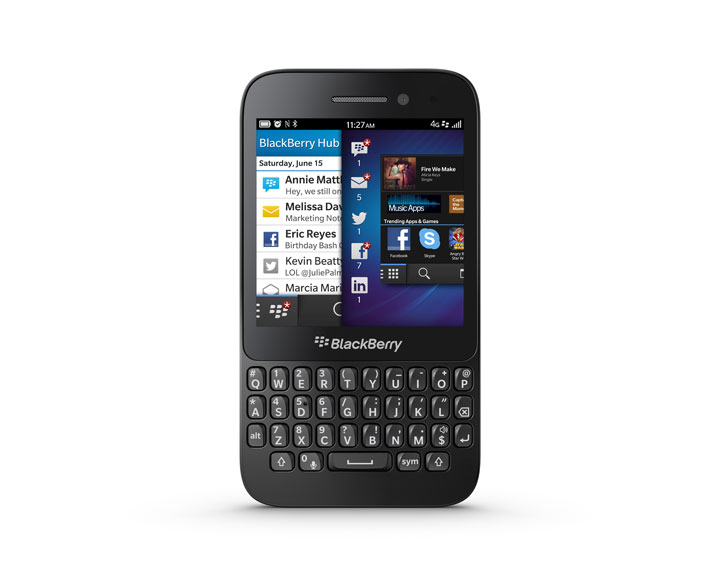TORONTO – When Canadian smartphone maker BlackBerry announced the BlackBerry Q5 in May it was pitched as a “fun and youthful” phone destined for consumers in emerging markets.

But, in a twist, BlackBerry announced Tuesday that the Q5 will be making its way into the hands of Canadian consumers – despite the fact that the Canadian market is right in the thick of North America’s incredibly saturated and already emerged smartphone market.
It’s a move that marketing expert John-Kurt Pliniussen says “makes no sense.”
Read More: BlackBerry to release Q5 smartphone in Canada
The Waterloo, Ont.-based company announced the Q5 in May during its annual tech conference in Orlando, Fla., making it the third smartphone release for BlackBerry in 2013.
The mid-tier phone, which features BlackBerry’s traditional QWERTY keyboard design, runs the new BlackBerry 10 operating system, but is less powerful than BlackBerry’s Q10 smartphone.
Originally, it was announced that the phone would only be available in selected markets, such as Europe, the Middle East, Africa, Asia, and Latin America.
Andrew MacLeod, Managing Director for Canada at BlackBerry, boasted home town pride and “strong partner support” as reasons to bring the phone to Canada.
“Canada is our home, and bringing the BlackBerry Q5 smartphone here is a testament to our strong partner support and ongoing commitment to delivering innovative technologies that enable Canadian enterprises and consumers to improve how they connect and communicate,” said MacLeod in the press release.
Global News reached out to BlackBerry for further comment on the decision to bring the Q5 to Canada. A spokesperson from BlackBerry told Global News that it is a misconception that the BlackBerry Q5 was designed for emerging markets, noting that the original press release for the device positioned it as a “youthful and fun device for selected markets.”
In the press release regarding the original announcement of the phone, BlackBerry did state that the phone would be released to “select” markets.
However, the markets listed on the original announcement were the Middle East, Africa, Asia, Latin America and select regions in Europe – all of which are considered emerging markets for smartphones.
Read More: BlackBerry entering into emerging markets good, but no savior: expert
Pliniussen, marketing expert and professor at Queen’s University School of Business, believes that the phone was originally geared towards emerging markets.
“It was not a misconception. They were clearly going for that market – they needed more market share and you can only gain market share in markets that are emerging – North America isn’t emerging,” Pliniussen told Global News.
“Can they go over there with a low-cost phone and get into markets where they have some perceived credibility – that was their plan, without a doubt and it made sense… on paper.”
The BlackBerry spokesperson also told Global News that carrier and retailer demand in Canada is high and due to the phones youthful feel, it will be a good option for younger customers and businesses looking for less-expensive options.
Telus sub-brand Koodo Mobile will be selling the device for $350 without a contract; however, other participating carriers have not yet released pricing information for the phone.
But, Pliniussen doubts that this price point – if it stays relatively similar from carrier to carrier – is competitive enough to make a dent in the highly-competitive North American market.
“There are two things that motivate the consumer in the cellphone market; one is the monthly cost and the other is the cost of the phone and the features of the phone,” said Pliniussen.
“Even at $350 is not a good deal – $50 would be a good deal.”
The $350 price tag without a contact is lower than other smartphones – Koodo customers would pay $625 for the BlackBerry Z10 touch-screen model and $700 for the BlackBerry Q10 by itself.
But many customers still won’t buy a phone with fewer features, when they can pay a few hundred dollars more for the upgraded version, in Pliniussen’s opinion.
The main problem, Pliniussen believes, is that the phone won’t be able to stand up to the competition because it was designed as a mid-tier phone and lacks some of the features that BlackBerry’s other devices have.
“Basically they are saying the Q5 is half of what the Q10 is. Why would anyone want a phone that’s half, or a third, or even 61 per cent of what the phone should be,” said Pliniussen.
The Q5 will be available starting August 13 for Bell, Fido, Koodo, Sasktel, TELUS, and Virgin Mobile Canada customers, as well as other retail stores.




Comments